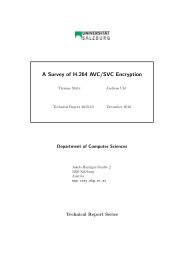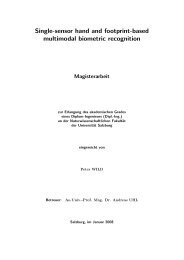Pit Pattern Classification in Colonoscopy using Wavelets - WaveLab
Pit Pattern Classification in Colonoscopy using Wavelets - WaveLab
Pit Pattern Classification in Colonoscopy using Wavelets - WaveLab
Create successful ePaper yourself
Turn your PDF publications into a flip-book with our unique Google optimized e-Paper software.
5 Results<br />
<strong>Pit</strong> <strong>Pattern</strong> Type I II III-L III-S IV V<br />
k-NN<br />
I 49 0 5 0 45 0<br />
II 36 0 14 0 49 0<br />
III-L 30 0 42 0 27 0<br />
III-S 25 0 50 0 25 0<br />
IV 33 0 14 0 51 0<br />
V 40 0 8 0 52 0<br />
SVM<br />
I 56 11 14 5 12 2<br />
II 33 37 2 4 19 5<br />
III-L 27 5 27 8 27 5<br />
III-S 25 0 50 8 8 8<br />
IV 27 13 13 2 40 4<br />
V 36 12 12 0 24 16<br />
Table 5.9: Result distribution matrices for BB for 6 classes (<strong>Pit</strong> pattern images)<br />
tractor “Subband energy”. The feature vector dimensions are quite different among the<br />
classifiers used, with s = 1, 1 for the k-NN classifier and s = 8, 41 for the SVM classifier<br />
(note that these values for s correspond to the number of subbands used to compute features<br />
for the two classes case and the six classes case, respectively).<br />
Additionally the k-value for the k-NN classifier differs very much between the two classes<br />
case and the six classes case, with k = 14 and k = 50, respectively.<br />
Figure 5.3 shows the results obta<strong>in</strong>ed for different choices for s and k <strong>in</strong> the six classes<br />
case us<strong>in</strong>g pit pattern images and the k-NN classifier.<br />
While figure 5.3(a) shows the classification results for all classes, figures 5.3(b)-(g) show<br />
the classification results for the separate classes. In these figures the color shows the classification<br />
result for a specific comb<strong>in</strong>ation of s and k, where a black pixel denotes a classification<br />
rate of 0% and yellow denotes a classifcation result of 100%.<br />
As we can see from 5.3(a) the best overall classification results are obta<strong>in</strong>ed by us<strong>in</strong>g a<br />
small value for s, while the choice of k does not play such an important role. As already<br />
po<strong>in</strong>ted out above, we can clearly see that for pit pattern types II, III-S and V the classification<br />
accuracy is very low no matter what choice we make for s and k. For all other types we<br />
clearly obta<strong>in</strong> better classification results.<br />
70








